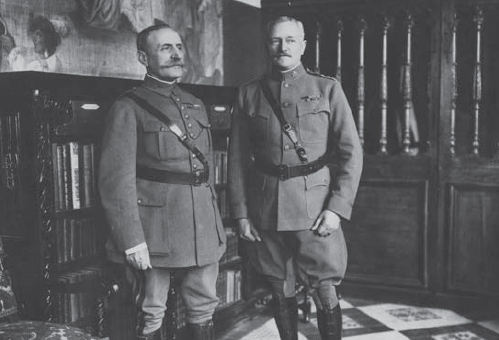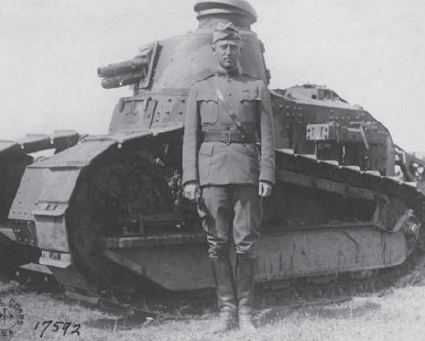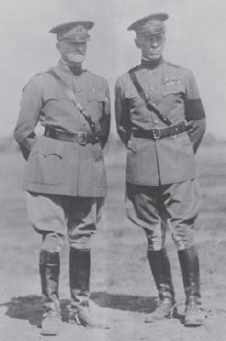
John Joseph Pershing was a schoolteacher for several years before securing an appointment to West Point Military Academy in 1882 at the age of 22. After graduating in 1886 Pershing served with the 6th Cavalry Regiment on the American western frontier. Pershing taught military science at the University of Nebraska while earning a law degree. He served in Cuba with the 10th (Negro) Cavalry Regiment during the Spanish American War, winning a commendation for his actions at San Juan Hill. Pershing found early military success during three tours in the Philippines battling the Moro insurgents. He served as military attaché in Japan and studied the evolution of military tactics during the 1905 Russo-Japanese War.
In 1906 President Theodore Roosevelt promoted Pershing, now married to the daughter of a Republican senator, to brigadier-general, over the heads of 862 other officers. Pershing served as the Governor of Moro province in the Philippines before being selected in 1915 to command American forces pursuing Pancho Villa in Mexico. Although he was ultimately unsuccessful in capturing or killing Villa, his time in the southwest provided Pershing with experience overseeing an American expeditionary force dependent on extended supply lines. Pershing’s role also impressed President Woodrow Wilson and Secretary of War Newton Baker. In particular, the President and Secretary credited Pershing for his strict adherence to their initial instructions, which were intended to limit American intervention in Mexico.

Marshal Foch and Pershing enjoyed a cordial but strained relationship. While Pershing deferred to Foch in his role as Supreme Allied Commander he insisted that a separate American army be organized and allowed to conduct independent operations.
With America’s declaration of war in April 1917, Pershing was appointed to command the American forces in Europe on May 24, 1917. Arriving in Europe on June 8, Pershing began the work of building an American army, work that would see its fulfillment with the St Mihiel offensive. Pershing engaged in bitter conflict with both British and French political and military leadership over the training and ultimate disposition of American forces during the remainder of 1917 and into 1918. He resisted demands that American forces be amalgamated into British and French units. Initially the proposed amalgamation was intended to be the most efficient way to train American forces, but the crisis created by the German Spring Offensive of 1918 caused the British to demand an infusion of American manpower to supplement their depleted units. Pershing resisted intense pressure from the British and French for a change in American policy but modified the deployment program to respond to the crisis in the spring and early summer of 1918.
In response to Marshal Foch’s reversal of policy in late August 1918, Pershing committed the newly formed First US Army to a series of operations in the Meuse–Argonne that they were inadequately prepared to undertake. Although the St Mihiel offensive captured over 15,000 Germans and drove them from the salient it failed to trap the vast majority of them, and by agreeing to limit the scope of the offensive Pershing may have missed achieving a strategic coup in capturing Metz and the Briey Iron Basin.
George S. Patton was born on November 11, 1885, into a family with a strong military tradition. Patton’s ancestors had fought in the American Revolution, the Mexican War, and the American Civil War. Patton graduated from West Point in 1909 and joined the 15th Cavalry Regiment. An expert swordsman, Patton became the first Master of the Sword at the Mounted Service School in Fort Riley, Kansas. Patton commanded cavalry patrols along the Mexican border and joined Pershing on his expedition against Pancho Villa.
While serving on Pershing’s staff in France, Captain Patton requested appointment to the newly organized United States Tank Corps in October 1917. In November 1917 he became head of the American Expeditionary Force Light Tank School at Langres. Patton, who had no prior knowledge of tanks, quickly acquainted himself with both the British Mark VI and French Renault tanks. After spending two weeks visiting French and British training camps, driving tanks, and visiting the Renault manufacturing plants, Patton and 1st Lieutenant Elgin Braine submitted a policy paper proposing a structure for the organization of the American tank forces. Patton outlined a case for utilizing the French Renault tank, as well as proposing a system for supply, strategic transportation, recovery and salvage, and training. He also included a lengthy section on strategic and tactical deployment of tanks, based on his conversations with French and British counterparts.
Patton oversaw the development of the American Light Tank School at Bourg. By the end of March 1917 Patton had both men and tanks. While in command of the tank training program, inspired by the shoulder patch of the 82nd Division, Patton authorized the development of the armor symbol and special collar insignia.

Lieutenant-Colonel Patton was a key member of the newly created American Tank Corps and was responsible for the its early organization and training.

Lieutenant-Colonel George Marshall (right) with General Pershing. Marshall was elevated to the planning section of the First US Army and was responsible for developing a series of offensive plans for St Mihiel and the logistical planning for transitioning American forces for the Meuse–Argonne attack.
In August 1918, with preparations for the St Mihiel offensive about to begin, Patton, now promoted to lieutenant-colonel, was given command of the 1st Tank Brigade, consisting of two light-tank battalions. Patton was to play a pivotal role in the deployment of tanks in support of the St Mihiel offensive.
George Marshall was born December 31, 1880, in Uniontown, Pennsylvania, and attended the Virginia Military Institute, graduating in 1901. He joined the US Army in 1902 and served in the Philippines, returning in 1906 to enter officer-training school at Fort Leavenworth, Kansas. After earning his commission Marshall returned to service in the Philippines. Returning to the United States in 1916, Marshall was assigned to the 1st Division as Head of Operations and dispatched to France in June 1917 with Pershing.
Marshall spent the next year preparing the 1st Division for its introduction to combat. Marshall was responsible for coordinating the training and supplies for the division and, later, operational plans for raids. In May 1918 he oversaw the preparation of plans for the 1st Division attack at Cantigny. In July 1918 Marshall was reassigned to the Operations Section of the General Staff of General Headquarters, and was immediately assigned to prepare plans for an offensive to reduce the St Mihiel salient.
Over the next month Marshall worked on plans in response to the shifting number of American and French divisions to be committed to the operations. On August 20, 1918, Marshall was reassigned as Assistant to the Chief of Staff for the First US Army and continued to refine the plans for the attack. With Marshal Foch’s decision to limit the St Mihiel operation Marshall was required to both revise the plans for the attack and develop plans for the transfer of men and matériel to the Meuse–Argonne offensive.
Born in Tarbes, France, Ferdinand Foch attended the Jesuit College in St Etienne and joined the French Army in 1870, experiencing French defeat in the disastrous Franco-Prussian War. Foch entered the Ecole Polytechnique in 1871, was commissioned as a lieutenant in 1873, and entered the Staff College as a captain in 1885. Appointed as an instructor in 1895, Foch led a reappraisal of the French defeat in 1870 and a reappreciation of examining military history as a means of refining military doctrine. Foch spent the next 15 years rising in rank and alternating between field command and positions at the Staff College. At the outbreak of World War I Foch was a lieutenant-general in command of the French XX Corps.
The crisis of March 1918, when French and British armies were pressed to their breaking point by successive German attacks, resulted in Foch being elevated to Supreme Commander. As Supreme Commander, he was responsible for coordinating Allied strategy and allocating resources. Foch was made Marshal of France on August 6, 1918.
In August 1918, Foch reversed course after approving the creation of the First US Army and sanctioning the St Mihiel offensive. At the urging of British Field Marshal Douglas Haig, Foch adopted an overall strategic plan that required the First US Army to be deployed in the Meuse–Argonne in time to begin attacks in late September 1918. He also limited the scope of the St Mihiel offensive. The combination of revised objectives and reduced timetables put an immense strain on the American forces involved in the St Mihiel offensive.
Max von Gallwitz was born in Breslau, Germany, in 1852. He joined the Army in 1870 and served as an artillery officer in the Franco-Prussian War. In an army dominated by aristocrats and predominantly Protestant, Gallwitz, a commoner and a Catholic, was able to rise to the rank of colonel and became Chief of Artillery in the War Ministry. He became a major-general in 1902 and was promoted to general and and appointed as inspector of field artillery by 1911. In 1913 Kaiser Wilhelm elevated him into the ranks of the Prussian nobility.
Transferred back to the Western Front in late 1915, Gallwitz commanded in the Verdun and Somme sectors. Considering Gallwitz one of his best officers, Ludendorff assigned him to command the Metz region in 1916. After the failed Spring Offensive, Gallwitz was assigned to defend the Meuse–Moselle sector. In overall command of the St Mihiel salient, Gallwitz responded with acerbity to the American attack, correctly identifying the focus of the attack and rushing reserves forward to buttress the Michel Stellung and protect Metz. Gallwitz was confused by American inaction after the initial attack, convinced that the ultimate American objective was Metz.
After the defeat in the St Mihiel salient, Gallwitz again confronted Pershing and the First US Army in the Meuse–Argonne. Gallwitz took advantage of the difficult terrain and the inexperience of the First US Army, stalling the initial American drive with masterful use of his limited reserves. A renewed American effort in early October slowly wore down German resistance and contributed to the German surrender on November 11, 1918.
Erich Ludendorff was born in Kruszewnia, Posen, in April 1865. He was commissioned as a lieutenant in 1885 after graduating from the Cadet School at Plon. In 1893 he was selected for the War Academy and recommended for appointment to the General Staff. Ludendorff was made a colonel in 1911 and then a major-general in 1914. Between 1904 and 1913 Ludendorff served as a staff officer and was appointed Chief of Staff in East Prussia at the outbreak of the war. In combination with Hindenburg, Ludendorff won decisive victories at Tannenberg (1914) and Masurian Lakes (1915). In 1916 Ludendorff was appointed quartermaster general. In continued partnership with Hindenburg, Ludendorff pressured Kaiser Wilhelm to dismiss officers who supported a negotiated peace settlement. Ludendorff was the mastermind of the German offensives of early 1918, which resulted in the elevation of Ferdinand Foch to Supreme Allied Commander. In July 1918 Ludendorff took effective control of all aspects of the German war effort. With the withdrawal of Russia from the war, Ludendorff conceived the Spring Offensive, which was intended to win the war before the Americans could tip the balance. The failure of the Spring Offensive to defeat the Allies resulted in the exhaustion of German offensive capabilities. By the time of the St Mihiel offensive Ludendorff suffered from both mental and physical exhaustion. He would later describe the news of the American offensive as “the worst days of my life.”